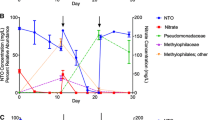Abstract.
Sulfolane (tetrahydrothiophene-1,1-dioxide) is used in the Sulfinol process for natural gas sweetening. At many sour-gas processing plants spills, landfills and leakage from unlined surface storage ponds have contaminated groundwaters with sulfolane. Due to its high water solubility and mobility in aquifers, sulfolane poses a risk for off-site contamination. This study investigated the aerobic biodegradation of sulfolane by two mixed microbial enrichment cultures and by three bacterial isolates. Sulfolane served as the sole C, S and energy source for these cultures. In the two mixed cultures, 60% and 80% of the sulfolane C was recovered as CO2, whereas in cultures of the three isolates only 40–42% of the substrate C was recovered as CO2. In the mixed cultures, 81% and 97% of the sulfolane S was converted to sulfate, and in the pure isolates, 55–90% of the substrate S was converted to sulfate. Thus, the mixed cultures were capable of greater mineralization than the pure isolates. One isolate, strain WP1, was identified using a combination of 16S rRNA gene sequencing, physiological traits and cell morphology. WP1 was determined to be most similar to Variovorax paradoxus.
Similar content being viewed by others
Author information
Authors and Affiliations
Additional information
Electronic Publication
Rights and permissions
About this article
Cite this article
Greene, E., Beatty, P. & Fedorak, P. Sulfolane degradation by mixed cultures and a bacterial isolate identified as a Variovorax sp.. Arch Microbiol 174, 111–119 (2000). https://doi.org/10.1007/s002030000184
Received:
Revised:
Accepted:
Issue Date:
DOI: https://doi.org/10.1007/s002030000184




